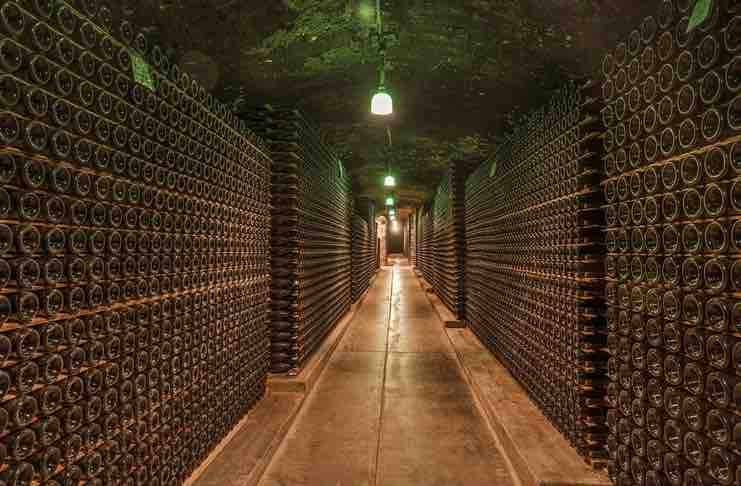Looking to learn the proper way to store wine? If you’ve found yourself with a nice bottle of wine that you’d like to save up for a special occasion or if you’ve begun collecting wine and want to know how best to care for it, you’re going to need to learn about storing wine.
As it turns out, how and where you store a bottle of wine can have a big impact on the freshness and taste of your wine when the bottle is finally open. Poor wine storage can result in spoiled or devalued wine.
The following will explore some of the things you need to keep in mind as you decide how to store your wine.
7 Tips For The Proper Way to Store Wine:
1. The Temperature Of The Room Is Important
Temperature is probably the most critical factor when it comes to wine storage. This is because a room that is too hot or too cold can result in spoiled wine pretty quickly. Typically your ideal temperature is going to be somewhere around 55 degrees Fahrenheit (or 13 degrees celsius). However, in some cases, a specific wine will have a particular temperature that is best. This can be discovered by consulting the manufacturer of the wine.
2. How Cold Is Too Cold?
When it comes to spaces that are too cold (think about basements or garages in the winter), you must make sure the room you store your wine is above 25 degrees Fahrenheit (negative four degrees celsius). If space dips below this temperature, even for just a few hours, your wine can freeze.
When this happens, the wine bottle might burst as the frozen wine within will have expanded. Not only does this mean you won’t be able to drink your wine, but you’ll probably be stuck cleaning up broken glass as well.
3. How Hot Is Too Hot?
If your wine storage area is above 68 degrees Fahrenheit (or 20 degrees celsius), the aging process of your wine can be accelerated. This will result in the destruction of volatile compounds and ultimately spoiled wine.
The experts describe this as cooked wine. As a general rule, the older your wine, the faster it will cook, and the more important it is for you to utilize a cooling device. Even more upsetting, there is nothing that can be done to save cooked wine. The flavor is ruined permanently if this happens.
4. Wine Likes To Be Kept On Its Side
This is probably one of the easiest things for you to adjust on your proper way to store wine. Storing wine horizontally is the way to go. This is because the wine inside the bottle stays in contact with the cork, and, therefore, keeps the cork moist. Cork is a spectacular yet sometimes debated material in the wine industry and has been used by humans for nearly 4000 years.
If it is allowed to dry out (which can happen in a relatively short period of time), seepage can occur, resulting in premature aging. As a side note, wine bottles with corkless tops that screw on do not need to be kept on their side. Despite this, wine collectors often store corkless bottles on their sides anyway because it is an efficient use of space, especially if you find yourself with many wine bottles.
5. Pay Attention To The Lighting
There’s a reason wine tends to come in dark bottles. The UV light from the sun can damage the delicate chemical balance of the wine. It is best to store your wine in a darker place out of direct sunlight because of how sensitive wine is to light. This is why wine is often kept in cellars below ground level.
6. Watch Out For Vibrations
Again, because the chemical balance of the wine is so delicate, you need to be careful about vibrations. Things like washing machines, dryers, loudspeakers, or even vacuum cleaners too close to your wine can shake the bottles up. Wine needs to be left steady for the right kind of aging to be happening at the right speed. Shake things up too quickly, and you can end up with some icky, spoiled wine.
7. Don’t Forget About The Humidity Of Your Space
The proper way to store wine naturally includes humidity as well. Just like leaving wine standing vertically can result in a dried-out cork and seepage, keeping your wine in a space that is too dry can also leave you with seepage-spoiled wine. Therefore, 60% humidity is, in general, considered ideal, but your wine can typically handle something between 50% and 70% humidity.
There you have it. By keeping the above tips in mind, you’re well on your way to making sure that your wine is given the best possible chance of staying fresh and aromatic for years to come. Of course, every wine is a little bit different, and the above should be considered as guidelines only. Reach out to the producers of your particular wine to get exact temperatures or humidity levels.
Want to read more of our wine posts? Check our tips for selling your wine collection, or our picks for the best wines to pair with pizza, or a few reasons why drinking wine is good for you.
